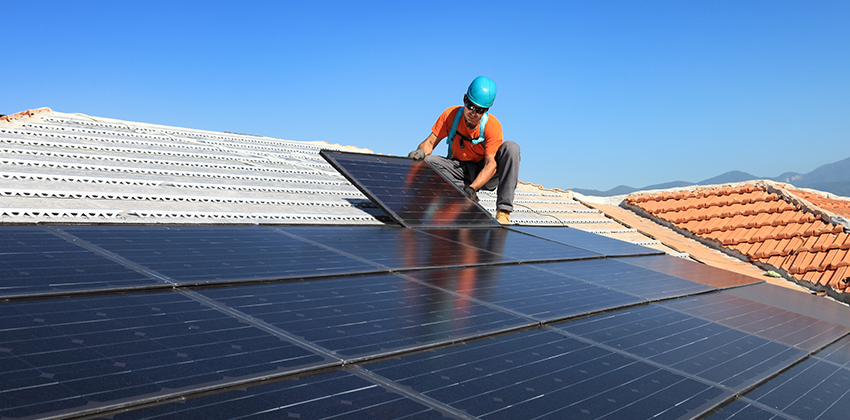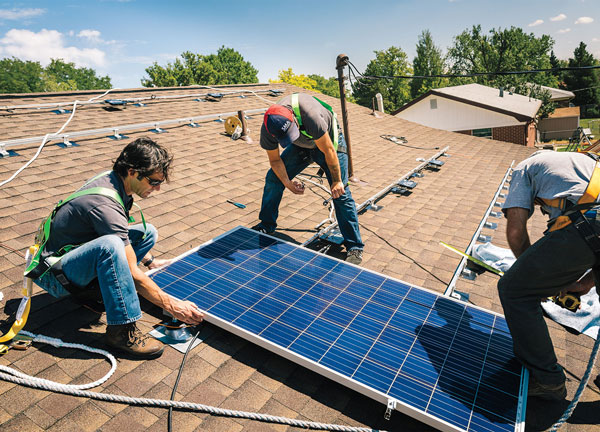Solar Energy Panels: Ways Solar Panel Installation May Boost Property Value
Solar Panel System: Home Roof Photovoltaic Systems Are An Outstanding Way To Decrease Energy Costs And Promote Sustainability
Installation Process and Requirements
Preparing Your Roof for Solar Panels
Before the first solar panel kisses your rooftop, a thorough inspection is vital. Envision your roof as a blank canvas-- it should be sturdy and ready to welcome the modification. Roofing system age, product, and angle play pivotal roles. Have you ever climbed to check your shingles? This easy act can reveal covert damage or weaknesses that could make complex installation. A well-prepared roofing system not only supports the panels but likewise ensures longevity and safety.
Step-by-Step Setup
- Website Evaluation: Professionals examine sunshine exposure, shading, and roof design to optimize panel positioning.
- System Design: Personalized solar selections are created to match your energy requirements and roof structure.
- Permitting: Required authorizations are secured-- think of this as getting the thumbs-up from local authorities.
- Installing Setup: Racking systems are anchored securely to your roof, ready to hold the photovoltaic panels.
- Panel Placement: Panels are located and bolted down, aligning perfectly to catch maximum sunlight.
- Electrical Wiring: Panels link to your home's electrical system through an inverter, converting sunlight into functional energy.
- Inspection and Activation: Last checks ensure whatever functions effortlessly before flipping the switch.
Essential Requirements for a Smooth Setup
- Structural Stability: Your roof must support the weight of the panels and racking system, typically around 2-4 pounds per square foot.
- Sunshine Direct Exposure: Ideally, your roofing should get a minimum of 6 hours of direct sunlight daily, devoid of shading by trees or buildings.
- Area Schedule: Sufficient roofing system area ensures enough panels can be installed to satisfy your energy objectives.
- Electrical Compatibility: Your home's wiring and electrical panel should accommodate the brand-new planetary system securely.
What Can Go Wrong-- and How to Avoid It
Often, even the best-laid plans can hit a snag. Photo a neighbor whose solar panels were installed without inspecting for roofing system leaks. Months later on, water damage surfaced, turning a financial investment into a headache. To sidestep such mistakes, demand an expert roofing system evaluation and clear interaction with your installer.

Quick Checklist Before Setup
| Requirement | Why It Matters | Idea |
|---|---|---|
| Roof Condition | Makes sure support and toughness | Repair any damages beforehand |
| Sun Direct exposure | Maximizes energy production | Cut neighboring trees if required |
| Electrical System | Supports system combination | Speak with a certified electrician |
| Permits | Compliance with regional policies | Start early to avoid hold-ups |
Does the concept of changing your roofing into a personal power plant thrill you? It should. With the right preparation and understanding of the setup procedure, turning sunshine into savings can be a smooth journey rather than a labyrinth of confusion.
Opening the Power: Why Residential Solar Panels Transform Houses
Picture getting up to sunlight streaming through your windows, knowing that those rays are fueling your whole home. Residential photovoltaic panels do not just catch energy; they harness a quiet revolution. But what exactly makes them a game-changer beyond the apparent savings on electricity expenses?
The Subtle Gains Beyond Cost Savings
Electrical power costs plunge, yes, however the genuine magic lies deeper. Solar panels create a buffer against the unpredictable spikes in energy costs. Have you ever felt caught by skyrocketing energy rates? Solar power offers a type of liberty, a financial shield that grows stronger each year. Plus, homes geared up with planetary systems frequently see an uptick in value-- yet this isn't practically dollars. It has to do with owning a piece of the future.
Environmental Effect Woven Into Daily Life
Every panel set up is a statement, a peaceful disobedience versus carbon footprints. Unlike standard power sources that choke the air with toxins, solar energy is a breath of fresh air-- actually. Consider the stories of communities once shrouded in smog, now basking under clearer skies thanks to widespread solar adoption. This isn't simply innovation; it's an ecological renaissance.
Professional Tips for Optimizing Solar Efficiency
- Position panels to record the sun's trajectory throughout the year, not simply peak hours.
- Frequently look for shading from new tree development-- shadows can dramatically reduce output.
- Consider incorporating a solar battery to save excess energy for nighttime usage.
- Optimize inverter settings to balance peak efficiency with durability.
Unanticipated Advantages That Often Go Undetected
Sound pollution is another tricky offender in urban living. Solar panels operate quietly, unlike generators or a/c systems that shout away. This subtle shift can change your home environment into a sanctuary of calm. And what about strength? During grid failures, planetary systems equipped with backup options can keep important devices humming, a modern lifeline when the unanticipated strikes.
Breaking Down the Investment: What to Anticipate
| Benefit | Effect | Long-Term Value |
|---|---|---|
| Energy Self-reliance | Lowers dependence on varying grid power | Steady and predictable energy expenses |
| Ecological Contribution | Lower carbon emissions | Supports sustainable living values |
| Home Value Increase | Destination to eco-conscious purchasers | Possibly greater resale cost |
| Energy Efficiency | Optimizes family power use | Lowered waste and better resource management |
Is Solar a Suitable For Every Home?
Not all roofs are equal. Some deal with structural limitations or are shaded by surrounding structures. However before dismissing the idea, think about imaginative installing options like ground selections or solar shingles. Concern your presumptions: can your home's orientation or roof angle be adapted to accept this technology? Typically, the real barrier isn't physical-- it's the hesitation to reconsider energy habits.
Checking out the Spectrum of Residential Solar Panel Technologies
Ever stood below a solar panel, wondering how such a sleek piece of technology turns sunlight into usable energy? The response Solar Panels depends on the unique types of solar panels available for domestic use, each boasting its own quirks and effectiveness. Imagine a sunny afternoon where the sun's rays strike a roofpaneled with monocrystalline cells, those deep black appeals known for their high effectiveness and durability. They whisper promises of robust energy output and a streamlined look that matches modern homes.
Monocrystalline Solar Panels: The Elite Performers
Monocrystalline panels are crafted from a single silicon crystal-- think about it as the photovoltaic panel equivalent of a completely cut diamond. This purity enables electrons to flow easily, improving energy effectiveness. Property owners typically favor these panels for their streamlined, uniform appearance and superior performance in limited space. Their production is energy-intensive, showing an intriguing paradox: high output comes with a hefty manufacturing footprint. Yet, the benefit is a panel that can quietly power your home for decades.
Polycrystalline Solar Panels: The Budget-Friendly Workhorses
Polycrystalline panels look like a mosaic of silicon pieces melted together, leading to a bluish shade with a speckled texture. They're less efficient than their monocrystalline cousins-- about 15-17% effectiveness compared to 20%+-- however their cost-effectiveness makes them enticing. If your rooftop stretches kindly, these panels might just be the practical, wallet-conscious choice. If area is a high-end, the lower energy density might leave you longing for more.

Thin-Film Solar Panels: Flexibility in Focus
Thin-film innovation breaks the mold, actually. These panels are light-weight, flexible, and can be incorporated into unconventional surfaces like curved roofing systems and even windows. Their efficiency hovers around 10-12%, but their adaptability is unrivaled. Picture a home where solar panels mix flawlessly with architectural lines instead of sitting like large appendages. The trade-off lies in their reasonably short lifespan and the need for more surface area to harvest the very same quantity of energy as crystalline panels.
Key Considerations When Picking Photovoltaic Panel Tech
- Roofing area: Limited space prefers greater effectiveness panels like monocrystalline.
- Budget restraints: Polycrystalline provides a balance in between cost and efficiency.
- Style flexibility: Thin-film fits innovative setups but needs more area.
- Climate elements: Some innovations handle heat and shade better than others.
Expert Tips for Optimizing Solar Innovation Selection
- Assess your roof's orientation and shading patterns before deciding on a panel type.
- Consider the deterioration rate-- some panels lose effectiveness much faster, impacting long-term output.
- Aspect in temperature level coefficients; panels carry out in a different way under heat stress.
- Do not ignore the inverter compatibility; matching panel technology with inverter type takes full advantage of energy harvest.
Have you considered how a minor tilt angle or panel positioning can affect your energy harvest? It's a subtle dance between sunshine, innovation, and architecture. Comprehending these nuances transforms a simple rooftop into a powerhouse of sustainable energy.
Ecological Impact and Energy Cost Savings
Imagine the sun as an endless reservoir of power, quietly waiting above to sustain your home. Residential solar panels take advantage of this large ocean of energy, turning sunlight into electricity without the usual baggage of contamination or carbon emissions. It's not almost slashing your electric expense; it has to do with shrinking your carbon footprint to an almost undetectable speck.
How deep does this environmental advantage run? Consider this: standard energy sources typically rely on burning nonrenewable fuel sources, which release greenhouse gases that trap heat in the atmosphere. Photovoltaic panel, by contrast, create clean energy calmly and progressively. Over their 25-30 year lifespan, a typical domestic system can balance out a number of lots of CO.
2-- the equivalent of planting lots of fully grown trees.
Energy Savings: More Than Simply Numbers
Energy cost savings from photovoltaic panels extend beyond the obvious month-to-month energy decreases. The real magic takes place when you comprehend the interaction in between consumption routines and solar production:
- Peak sun hours align with daytime energy use, lowering reliance on grid power when electrical energy is most pricey and carbon-intensive.
- Net metering enables excess electrical power to recede to the grid, turning your rooftop into a tiny power plant and making credits.
- Energy storage services, such as home batteries, can save surplus solar energy, smoothing out supply throughout cloudy days or nighttime.
Subtle Subtleties That Matter
Have you ever questioned why two neighboring houses with identical solar setups report various savings? The angle of your roofing, shading from trees, and even panel cleanliness discreetly but considerably impact performance. A frequently neglected truth: even a thin layer of dust or pollen reduces output by as much as 5-10%-- a small information with a big effect.
Additionally, the ecological gains aren't almost clean energy. Production solar panels requires energy and products, however advances in technology now focus on reducing this "embodied energy." Panels made with recycled materials and longer lifespans tip the scales further in favor of sustainability.
Professional Tips for Making The Most Of Impact
- Optimize panel orientation and tilt to catch the maximum sunlight based on your geographic place.
- Integrate smart home energy management systems to integrate energy usage with peak solar production.
- Routinely check for shading changes triggered by new foliage development or building, which can silently wear down performance.
- Think about integrating solar with energy-efficient devices to amplify general savings.
| Aspect | Influence On Energy Savings | Ecological Ramification |
|---|---|---|
| Panel Performance | Directly proportional to energy output | Greater efficiency decreases land and resource use |
| Shading | Can decrease output by as much as 25% | Less tidy energy produced, more grid dependence |
| System Size | Identifies potential energy generation | Oversizing can squander materials; undersizing limits cost savings |
| Energy Storage | Improves self-consumption | Decreases requirement for fossil fuel backup power |
Photovoltaic panel do more than power homes-- they weave a story of resilience, innovation, and ecological stewardship. They invite property owners to ask themselves: Just how much am I ready to buy a future where tidy energy is the standard, not the exception?